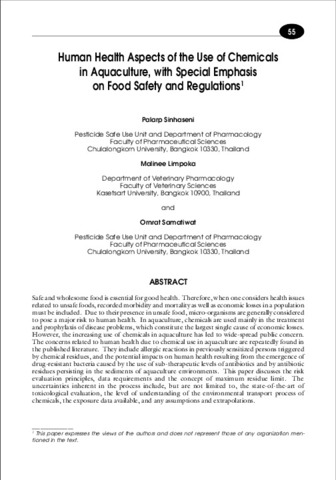Human health aspects of the use of chemicals in aquaculture, with special emphasis on food safety and regulations
Share
Abstract
Safe and wholesome food is essential for good health. Therefore, when one considers health issues related to unsafe foods, recorded morbidity and mortality as well as economic losses in a population must be included. Due to their presence in unsafe food, micro-organisms are generally considered to pose a major risk to human health. In aquaculture, chemicals are used mainly in the treatment and prophylaxis of disease problems, which constitute the largest single cause of economic losses. However, the increasing use of chemicals in aquaculture has led to wide-spread public concern. The concerns related to human health due to chemical use in aquaculture are repeatedly found in the published literature. They include allergic reactions in previously sensitized persons triggered by chemical residues, and the potential impacts on human health resulting from the emergence of drug-resistant bacteria caused by the use of sub-therapeutic levels of antibiotics and by antibiotic residues persisting in the sediments of aquaculture environments. This paper discusses the risk evaluation principles, data requirements and the concept of maximum residue limit. The uncertainties inherent in the process include, but are not limited to, the state-of-the-art of toxicological evaluation, the level of understanding of the environmental transport process of chemicals, the exposure data available, and any assumptions and extrapolations.
Suggested Citation
Sinhaseni, P., Limpoka, M., & Samatiwat, O. (2000). Human health aspects of the use of chemicals in aquaculture, with special emphasis on food safety and regulations. In J. R. Arthur, C. R. Lavilla-Pitogo, & R. P. Subasinghe (Eds.), Use of Chemicals in Aquaculture in Asia: Proceedings of the Meeting on the Use of Chemicals in Aquaculture in Asia, 20-22 May 1996, Tigbauan, Iloilo, Philippines (pp. 55-60). Tigbauan, Iloilo, Philippines: Aquaculture Department, Southeast Asian Fisheries Development Center.
Subject
safety regulations  ; Toxicants; drug resistance
; Toxicants; drug resistance  ; husbandry diseases
; husbandry diseases  ; environmental impact
; environmental impact  ; disease control
; disease control  ; antibiotics
; antibiotics  ; aquaculture
; aquaculture  ; Control resistance; disease transmission
; Control resistance; disease transmission  ; public health
; public health  ; allergic reactions
; allergic reactions  ; aquaculture economics
; aquaculture economics  ; disease prophylaxis
; disease prophylaxis  ; Health and safety; mortality causes
; Health and safety; mortality causes  ; Asia
; Asia
 ; Toxicants; drug resistance
; Toxicants; drug resistance  ; husbandry diseases
; husbandry diseases  ; environmental impact
; environmental impact  ; disease control
; disease control  ; antibiotics
; antibiotics  ; aquaculture
; aquaculture  ; Control resistance; disease transmission
; Control resistance; disease transmission  ; public health
; public health  ; allergic reactions
; allergic reactions  ; aquaculture economics
; aquaculture economics  ; disease prophylaxis
; disease prophylaxis  ; Health and safety; mortality causes
; Health and safety; mortality causes  ; Asia
; Asia
Collections
Related items
Showing items related by title, author, creator and subject.
-
Fish disease control in Japan
Miwa, Satoshi (Aquaculture Department, Southeast Asian Fisheries Development Center, 2019)The regulatory authority responsible for the control of aquatic animal diseases in Japan is the Animal Products Safety Division, Food Safety and Consumer Affairs Bureau, Ministry of Agriculture, Forestry, and Fisheries ... -
Aquatic emergency preparedness and response systems in Singapore
Chee, D.; Teo, X. H. (Aquaculture Department, Southeast Asian Fisheries Development Center, 2019)Singapore s population-dense, urban environment presents a unique context for her increasingly important aquaculture industry. This paper provides an overview of Singapore s existing aquatic emergency preparedness and ... -
Philippines: Aquatic emergency preparedness and response systems for transboundary diseases
Somga, Sonia S.; Somga, Joselito R.; Quiatchon, Gladys M.; Regidor, Simeona E. (Aquaculture Department, Southeast Asian Fisheries Development Center, 2019)The Bureau of Fisheries and Aquatic Resources (BFAR) of the Department of Agriculture as the Competent Authority, develops and implements rules and regulations on aquatic animal health for the Philippines. It establishes ...




